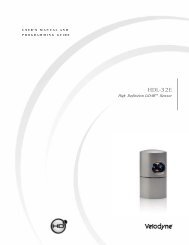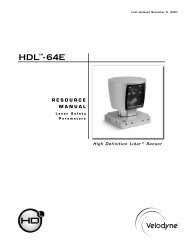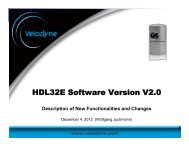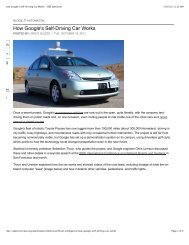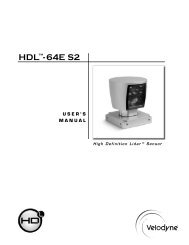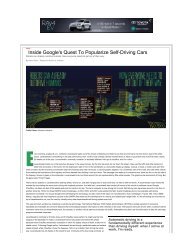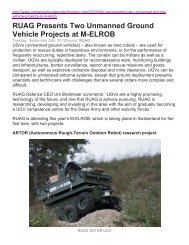On the Segmentation of 3D LIDAR Point Clouds - Velodyne Lidar
On the Segmentation of 3D LIDAR Point Clouds - Velodyne Lidar
On the Segmentation of 3D LIDAR Point Clouds - Velodyne Lidar
Create successful ePaper yourself
Turn your PDF publications into a flip-book with our unique Google optimized e-Paper software.
(a) (b) (c)<br />
Fig. 2. The GP-INSAC method from Algorithm 3 is run on simulated 2D data. A ground seed is chosen manually, shown in green. The output after <strong>the</strong><br />
first iteration is shown in (a), after three iterations in (b) and <strong>the</strong> 16th and final iteration in (c)<br />
computation time. Compression is performed in two stages<br />
in lines 1 and 2 <strong>of</strong> Algorithm 3. The data are first assigned<br />
to a fixed <strong>3D</strong> grid structure with a constant cell size <strong>of</strong> r<br />
metres. In each cell, <strong>the</strong> contents are represented by <strong>the</strong>ir <strong>3D</strong><br />
mean. In <strong>the</strong> second stage, <strong>the</strong> data are decimated by keeping<br />
1 in every d <strong>of</strong> <strong>the</strong> grid means. The first stage compresses<br />
<strong>the</strong> data towards uniform density, avoiding grid quantisation<br />
errors by calculating <strong>the</strong> means. The second stage allows<br />
fur<strong>the</strong>r compression, without requiring larger (less accurate)<br />
cell sizes.<br />
<strong>On</strong>ce <strong>the</strong> optional compression is performed, an initial<br />
seed <strong>of</strong> likely ground points is determined using <strong>the</strong> application<br />
specific Seed function. For this study, <strong>the</strong> points<br />
within a fixed radius R s <strong>of</strong> <strong>the</strong> sensor that are also below<br />
<strong>the</strong> base height B s <strong>of</strong> <strong>the</strong> sensor are chosen (|x| < R s<br />
and x z < B s ), assuming this region is locally uncluttered<br />
by non-ground objects. INSAC is <strong>the</strong>n performed as per<br />
Algorithm 2, on <strong>the</strong> decimated grid means. This classifies<br />
<strong>the</strong> decimated grid mean data into <strong>the</strong> three classes; inliers,<br />
outliers or unknown and provides <strong>the</strong> GP model representing<br />
<strong>the</strong> continuous ground surface according to <strong>the</strong> inliers.<br />
The data are <strong>the</strong>n decompressed in lines 5 and 6 <strong>of</strong><br />
Algorithm 3. The GP model (from <strong>the</strong> decimated means)<br />
is used to classify all <strong>of</strong> <strong>the</strong> un-decimated means, using<br />
<strong>the</strong> same function from <strong>the</strong> INSAC method in line 7 <strong>of</strong><br />
Algorithm 2 and Equation III-C.1. Finally, <strong>the</strong> class <strong>of</strong> <strong>the</strong><br />
grid means is applied to <strong>the</strong> full input data by cell correspondence,<br />
using GridMeanDecompress. The output is <strong>the</strong><br />
full classification <strong>of</strong> <strong>the</strong> original data, as inliers (belonging<br />
to <strong>the</strong> ground), outliers (belonging to an object) or unknown<br />
(could not be classified with high certainty).<br />
For sparse segmentation, <strong>the</strong> ground data produced<br />
by GP-INSAC in Algorithm 3 are considered as one<br />
partition. The non-ground data are <strong>the</strong>n processed by<br />
SegmentVoxelGrid with <strong>the</strong> Cluster-All method from<br />
Section III-B.2 to produce <strong>the</strong> remaining non-ground partitions.<br />
Unknown points remain classified as such.<br />
In Section V, <strong>the</strong> performance <strong>of</strong> <strong>the</strong> algorithm is demonstrated<br />
with different parameter values and optimal parameter<br />
choices are given by comparison with hand partitioned data.<br />
2) Mesh Based <strong>Segmentation</strong>: The Mesh Based <strong>Segmentation</strong><br />
algorithm involves three main steps: (1) construction<br />
<strong>of</strong> a terrain mesh from a range image; (2) extraction <strong>of</strong> <strong>the</strong><br />
ground points based on <strong>the</strong> computation <strong>of</strong> a gradient field<br />
in <strong>the</strong> terrain mesh; (3) clustering <strong>of</strong> <strong>the</strong> non-ground points<br />
using <strong>the</strong> Cluster-All method.<br />
The generation <strong>of</strong> a mesh from a range image follows <strong>the</strong><br />
approach in [10], which exploits <strong>the</strong> raster scan arrangement<br />
for fast topology definition (around 10 ms per scan). An<br />
example <strong>of</strong> <strong>the</strong> resulting mesh is shown in Fig. 3(a). With<br />
sparse data, such a mesh creates a point-to-point connectivity<br />
which could not be captured with a constant resolution grid.<br />
As a consequence <strong>the</strong> ground partition can be grown from<br />
a seed region (here, <strong>the</strong> origin <strong>of</strong> <strong>the</strong> scan) through <strong>the</strong><br />
connected topology.<br />
<strong>On</strong>ce <strong>the</strong> terrain mesh is built, <strong>the</strong> segmenter extracts<br />
<strong>the</strong> ground (function ExtractGround in algorithm 1) by<br />
computing a gradient field in <strong>the</strong> mesh. For each node (i.e.<br />
laser return), <strong>the</strong> gradient <strong>of</strong> every incoming edge is first<br />
evaluated. The gradient value for <strong>the</strong> node is chosen as <strong>the</strong><br />
one with <strong>the</strong> maximum norm. The four links around a given<br />
node are identified as: {UP, DOWN, LEFT, RIGHT}, with<br />
DOWN pointing toward <strong>the</strong> origin <strong>of</strong> <strong>the</strong> scan. To compute<br />
<strong>the</strong> gradient on <strong>the</strong> DOWN edge, for instance, <strong>the</strong> algorithm<br />
traverses <strong>the</strong> mesh from one node to <strong>the</strong> following in <strong>the</strong><br />
DOWN direction until a distance <strong>of</strong> mingraddist is covered.<br />
The gradient is <strong>the</strong>n obtained as <strong>the</strong> absolute difference <strong>of</strong> <strong>the</strong><br />
height <strong>of</strong> <strong>the</strong> starting and ending node divided by <strong>the</strong> distance<br />
between <strong>the</strong>m. If a mingraddist length is not covered in<br />
a given direction, <strong>the</strong> gradient is disregarded. Enforcing a<br />
minimum gradient support length allows noise to be averaged<br />
out: as can be seen in Fig. 3(a), <strong>the</strong> nodes nearer to <strong>the</strong> centre<br />
<strong>of</strong> <strong>the</strong> scan are nearer to each o<strong>the</strong>r, which generates noisy<br />
gradient estimates if consecutive nodes are used to calculate<br />
<strong>the</strong> gradients (since <strong>the</strong> noise in <strong>the</strong>ir height values is <strong>of</strong> <strong>the</strong><br />
same magnitude as <strong>the</strong> length <strong>of</strong> <strong>the</strong> links connecting <strong>the</strong>m).<br />
<strong>On</strong>ce <strong>the</strong> gradient field is computed, <strong>the</strong> ground partition<br />
is obtained by growing a cluster <strong>of</strong> ground nodes from <strong>the</strong><br />
closest to <strong>the</strong> fur<strong>the</strong>st raster line. In <strong>the</strong> closest raster line<br />
(<strong>the</strong> inner most ring in Fig. 3(a)), <strong>the</strong> label GROUND is<br />
assigned to <strong>the</strong> longest sequence <strong>of</strong> nodes s g with gradients<br />
below maxgrad. Additionally, sequences <strong>of</strong> nodes s i from<br />
<strong>the</strong> inner ring with gradients below <strong>the</strong> threshold maxgrad<br />
are also marked GROUND if, given that n i and n g are<br />
<strong>the</strong> closest nodes in s i and s g , respectively, <strong>the</strong>ir height<br />
is within maxdh. For <strong>the</strong> o<strong>the</strong>r raster lines, a node is<br />
marked as GROUND if its gradient value is below maxgrad,<br />
and it has at least one <strong>of</strong> its direct neighbours already<br />
identified as GROUND; whe<strong>the</strong>r this neighbour is in <strong>the</strong><br />
same raster line or in <strong>the</strong> previous one. This last requirement<br />
encodes <strong>the</strong> iterative growing <strong>of</strong> <strong>the</strong> ground partition and<br />
avoids non-ground flat partitions (such as <strong>the</strong> ro<strong>of</strong> <strong>of</strong> a<br />
car) to be mistaken as part <strong>of</strong> <strong>the</strong> ground. This propagation<br />
process assumes that <strong>the</strong> ground can be observed around <strong>the</strong><br />
sensor; more specifically, it assumes that at least part <strong>of</strong> <strong>the</strong><br />
raster line nearest <strong>the</strong> sensor falls on <strong>the</strong> ground, and <strong>the</strong><br />
corresponding set <strong>of</strong> nodes form <strong>the</strong> longest flat sequence.<br />
The propagation <strong>of</strong> <strong>the</strong> GROUND label is performed in both




